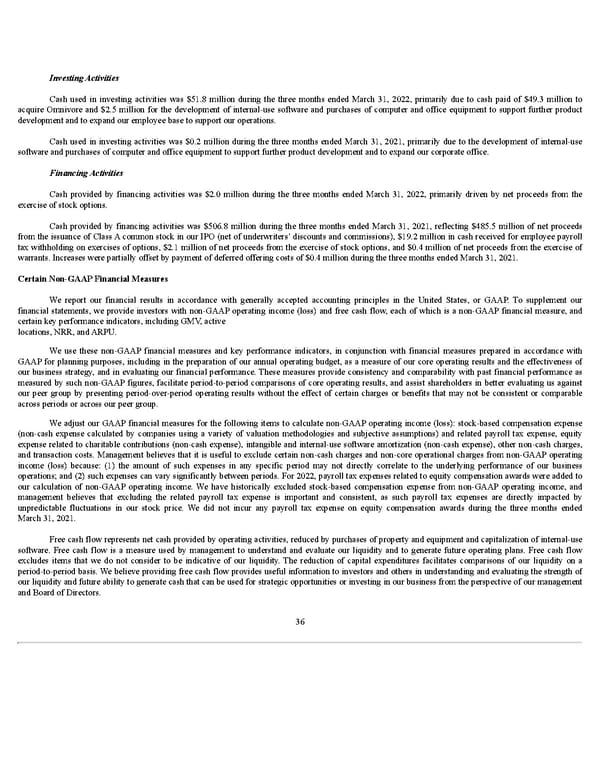Investing Activities Cash used in investing activities was $51.8 million during the three months ended March 31, 2022, primarily due to cash paid of $49.3 million to acquire Omnivore and $2.5 million for the development of internal-use software and purchases of computer and office equipment to support further product development and to expand our employee base to support our operations. Cash used in investing activities was $0.2 million during the three months ended March 31, 2021, primarily due to the development of internal-use software and purchases of computer and office equipment to support further product development and to expand our corporate office. Financing Activities Cash provided by financing activities was $2.0 million during the three months ended March 31, 2022, primarily driven by net proceeds from the exercise of stock options. Cash provided by financing activities was $506.8 million during the three months ended March 31, 2021, reflecting $485.5 million of net proceeds from the issuance of Class A common stock in our IPO (net of underwriters’ discounts and commissions), $19.2 million in cash received for employee payroll tax withholding on exercises of options, $2.1 million of net proceeds from the exercise of stock options, and $0.4 million of net proceeds from the exercise of warrants. Increases were partially offset by payment of deferred offering costs of $0.4 million during the three months ended March 31, 2021. Certain Non-GAAP Financial Measures We report our financial results in accordance with generally accepted accounting principles in the United States, or GAAP. To supplement our financial statements, we provide investors with non-GAAP operating income (loss) and free cash flow, each of which is a non-GAAP financial measure, and certain key performance indicators, including GMV, active locations, NRR, and ARPU. We use these non-GAAP financial measures and key performance indicators, in conjunction with financial measures prepared in accordance with GAAP for planning purposes, including in the preparation of our annual operating budget, as a measure of our core operating results and the effectiveness of our business strategy, and in evaluating our financial performance. These measures provide consistency and comparability with past financial performance as measured by such non-GAAP figures, facilitate period-to-period comparisons of core operating results, and assist shareholders in better evaluating us against our peer group by presenting period-over-period operating results without the effect of certain charges or benefits that may not be consistent or comparable across periods or across our peer group. We adjust our GAAP financial measures for the following items to calculate non-GAAP operating income (loss): stock-based compensation expense (non-cash expense calculated by companies using a variety of valuation methodologies and subjective assumptions) and related payroll tax expense, equity expense related to charitable contributions (non-cash expense), intangible and internal-use software amortization (non-cash expense), other non-cash charges, and transaction costs. Management believes that it is useful to exclude certain non-cash charges and non-core operational charges from non-GAAP operating income (loss) because: (1) the amount of such expenses in any specific period may not directly correlate to the underlying performance of our business operations; and (2) such expenses can vary significantly between periods. For 2022, payroll tax expenses related to equity compensation awards were added to our calculation of non-GAAP operating income. We have historically excluded stock-based compensation expense from non-GAAP operating income, and management believes that excluding the related payroll tax expense is important and consistent, as such payroll tax expenses are directly impacted by unpredictable fluctuations in our stock price. We did not incur any payroll tax expense on equity compensation awards during the three months ended March 31, 2021. Free cash flow represents net cash provided by operating activities, reduced by purchases of property and equipment and capitalization of internal-use software. Free cash flow is a measure used by management to understand and evaluate our liquidity and to generate future operating plans. Free cash flow excludes items that we do not consider to be indicative of our liquidity. The reduction of capital expenditures facilitates comparisons of our liquidity on a period-to-period basis. We believe providing free cash flow provides useful information to investors and others in understanding and evaluating the strength of our liquidity and future ability to generate cash that can be used for strategic opportunities or investing in our business from the perspective of our management and Board of Directors. 36
 Q1 2022 10Q Page 39 Page 41
Q1 2022 10Q Page 39 Page 41